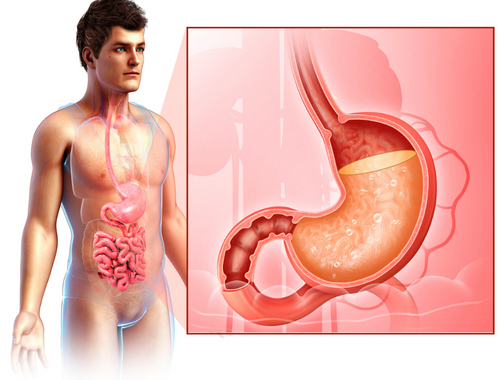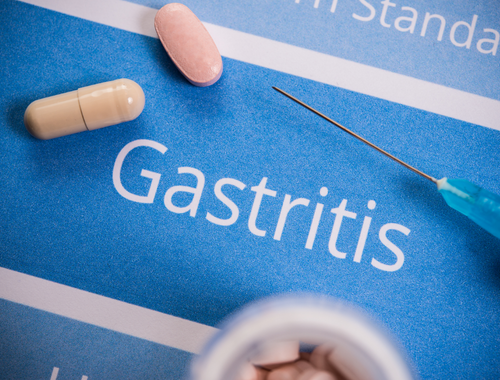Difference Between Normal Stomach and Gastritis
The stomach is a key organ for food digestion. It is a bag of muscles that releases enzymes and acids that break down the food particles. The protective inner layer of the stomach is the mucosa. Disruption of the mucosal lining of the stomach leads to inflammation which is called gastritis.

What is the stomach?
Definition:
The stomach is a J-shaped muscular organ. It secretes acidic juices and proteolytic enzymes that break down food particles into smaller portions to be further digested in the small intestine.
Location of the stomach:
The organ sits in the upper left quadrant of the abdomen. It connects to the esophagus above via the lower esophageal sphincter and to the small intestine below via the pyloric sphincter.
Layers of the stomach:
Mucosa is the innermost lining of the stomach. It expands when the stomach is distended after being full. Submucosa sits above the mucosa and is composed of blood vessels, lymphatics, connective tissue, and neurons. It is the protective layer of mucosa. Muscularis externa is the muscular layer of the stomach. The layer covering the stomach is serosa.
Parts of the stomach:
The stomach comprises of five distinct regions: the topmost cardia which connects with the esophagus, the fundus adjacent to the cardia and just below the diaphragm, the body, which is the largest section, the antrum and the lowermost pylorus which connects to the small intestine.
Diseases affecting the stomach:
Conditions affecting the stomach include gastric ulcers, gastritis, gastroesophageal reflux disease, indigestion, gastroparesis, peptic ulcer disease, and gastric cancer.
Prevention of diseases:
In order to maintain a healthy stomach and gut, lifestyle modifications are necessary. These include drinking moderate quantities of alcohol, having a good fluid intake, incorporating fiber into the diet, ample exercise, and stress reduction. Excessive use of processed food is discouraged and so is smoking.

What is gastritis?
Definition:
Gastritis is an inflammation of the inner mucosal layer of the stomach. It manifests as dyspepsia, regurgitation, stomach pain, nausea, and indigestion.
Causes:
Anything which damages or erodes the stomach lining can lead to gastritis. Chronic alcohol and prolonged use of nonsteroidal anti-inflammatory drugs (NSAIDs) can cause gastritis. Gastritis can be due to autoimmune etiology as well. Helicobacter pylori is the most common cause of peptic ulcer disease and gastritis. Other causes of gastritis include bile reflux, trauma, severe burns, and brain injury.
Symptoms of gastritis:
Common symptoms of gastritis include bloating, nausea, vomiting, black tarry stools, indigestion, weight loss, abdominal pain, and hematemesis.
Layers affected:
The mucosal lining is the affected gastric layer in gastritis.
Diagnosis:
H. pylori breath test is done initially to identify suspected gastritis. If bacteria are present, a breath test will pick the increase in carbon dioxide. Blood tests are requested which detect antibodies for H pylori. A stool antigen test is also important. The definitive investigation is upper endoscopy which confirms the diagnosis.
Treatment:
Proton pump inhibitors such as Omeprazole, and esomeprazole are the mainstay drugs for treating gastritis. These reduce the acid produced by the stomach. Histamine (H2) blockers such as Cimetidine as also important to slow down the disease progression. Additionally, antibiotics and antacids may be needed to reduce indigestion and infection.
Complications:
If left untreated, gastritis can lead to life-threatening complications. These include anemia due to excessive blood loss through upper gastrointestinal bleeding and peritonitis if the ulcer perforates. The affected individual can develop pernicious anemia if the gastritis is of autoimmune etiology. Furthermore, gastritis increases the risk of acquiring gastric cancer.
Difference between normal stomach and gastritis
Definition:
The stomach is a J-shaped muscular organ that secretes acidic juices and proteolytic enzymes that digest food particles. Gastritis is an inflammation of the inner mucosal layer of the stomach.
Parts of the stomach and parts affected in gastritis:
The stomach comprises of five regions: the upper cardia which connects with the esophagus, the fundus adjacent to the cardia and just below the diaphragm, the body of the stomach, which is the largest section, the antrum and the lowermost pylorus which connects to the small intestine.
H. pylori-associated gastritis mainly affects the antrum of the stomach whereas autoimmune gastritis affects the body of the stomach.
Layers of stomach and layers affected in gastritis:
Mucosa is the deepest layer of the stomach which is exposed to the acids and enzymes secreted by the glandular gastric epithelium. Above the mucosa is the submucosa which contains the vasculature and lymphatics. The muscular layers then overline the submucosa. Serosa is the outer covering layer of the stomach. Gastritis is the inflammation of the innermost mucosal layer of the stomach.
Physiology:
Stomach walls contain glands that secrete mucus, acidic juices, and proteolytic enzymes that break down food particles and help in their digestion. Mucosal injury secondary to medications like NSAIDs, autoimmune pathologies, burn injury, H. pylori infection, dietary factors, or stress can lead to gastritis.
Prevention of gastric diseases and gastritis:
To maintain a healthy stomach environment, certain lifestyle modifications need to be incorporated. These include drinking moderate quantities of alcohol, having good hydration and fiber portions in diet, ample exercise, and stress reduction. Excessive use of processed food is discouraged and so is smoking.
Proper handwashing and sanitation help prevent the transmission of H. pylori infection. Preventive measures for gastritis include minimizing caffeine intake, eating smaller portions of food, avoiding fatty and acidic foods, avoiding NSAIDs, decreasing alcohol intake, and avoiding lying immediately after eating.
Table of differences between normal stomach and gastritis

FAQs
How do I know if my stomach pain is gastritis?
Worsening upper abdominal pain and indigestion, particularly after meals, are signs of gastritis. Other symptoms include belching, nausea, vomiting, and black stools.
How do they tell if you have gastritis?
Confirmed gastritis is only after a breath test, blood tests, stool tests, and endoscopy.
What can be mistaken for gastritis?
Gastritis can be confused with angina, myocardial infarction, pancreatitis, and gallbladder disorders.
How can you tell the difference between gastroenteritis and gastritis?
Gastritis does not cause diarrhea. Gastroenteritis has diarrhea along with nausea and vomiting.
- Differences Between Reptiles and Amphibians - May 17, 2024
- Difference Between Ophthalmology and Optometry - May 15, 2024
- Difference Between Fear and Anxiety - April 2, 2024
Search DifferenceBetween.net :
Leave a Response
References :
[0]Hunt, R. H., et al. "The stomach in health and disease." Gut 64.10 (2015): 1650-1668.
[1]Glickman, Jonathan N., and Donald A. Antonioli. "Gastritis." Gastrointestinal endoscopy clinics of North America 11.4 (2001): 717-740.
[2]Varbanova, Mariya, Katrin Frauenschläger, and Peter Malfertheiner. "Chronic gastritis–an update." Best Practice & Research Clinical Gastroenterology 28.6 (2014): 1031-1042.
